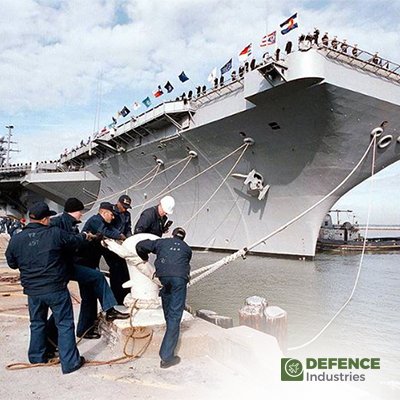Securing the Seas: Fenders, Moorings, and Anchors in Naval Operations 20 June 2024

Anchoring equipment plays a crucial role in naval operations and ensuring the safety and security of naval vessels. Ship anchor chains, anchor windlasses, and boat anchor winches are key components that contribute significantly to ship safety equipment standards. These elements not only facilitate safe anchorage but also play a vital role in marine security services.
In the realm of naval operations, the importance of proper anchoring equipment cannot be overstated. Ship anchor chains are designed to withstand the forces exerted during anchoring, providing a secure connection between the vessel and the seabed. Anchor windlasses are essential for deploying and retrieving anchors efficiently, while boat anchor winches assist in managing smaller vessels' anchoring processes. The role of mooring winches is also critical in ensuring the stability and security of naval vessels while docked or anchored. These winches are used to secure the vessel to a pier or mooring buoy, preventing drift and maintaining position even in adverse weather conditions.
When considering ship safety equipment, anchoring equipment forms a fundamental part of the overall safety measures onboard. Properly functioning anchor chains, windlasses, and winches contribute to safe navigation, especially during anchoring and mooring operations. In the context of marine security services, anchoring equipment becomes even more crucial. Armed maritime security teams rely on well-maintained and robust anchoring systems to ensure quick and effective responses to security threats. A secure anchor system allows vessels to maintain their position during security operations, enabling efficient coordination and response.
Moreover, with the increasing focus on marine cyber security, ensuring the integrity and functionality of anchoring equipment becomes a priority. Cyber threats can target critical systems onboard, including anchor control systems and mooring winch operations. Robust cybersecurity measures are essential to safeguarding these systems and preventing potential security breaches.
In conclusion, anchoring equipment is not just about securing a vessel in place; it is an integral part of naval operations, marine security services, and overall ship safety. From anchor chains to boat anchor winches, each component plays a vital role in maintaining the safety, security, and operational efficiency of naval vessels.
Anchoring Equipment Overview
Anchoring equipment is a vital component in the realm of naval operations and ensuring the safety and security of naval vessels. This equipment encompasses a diverse array of tools and mechanisms designed specifically to secure naval vessels in various maritime conditions. Among these components, the ship anchor chain stands out as a fundamental element. Crafted from high-strength steel, the ship anchor chain boasts robust construction, ensuring reliable anchoring even in adverse weather or challenging seabed conditions.
In addition to the ship anchor chain, other essential components of anchoring equipment include anchor windlasses and mooring winches. These devices, often powered by hydraulic or electric systems, provide the necessary mechanical advantage to handle anchor deployment and retrieval with precision and efficiency. Anchor windlasses play a pivotal role in managing the anchor's movements, while mooring winches are crucial for securing the vessel to a pier or mooring buoy, preventing drift and maintaining stability. The significance of anchoring equipment extends beyond mere functionality; it is an integral part of ship safety equipment standards. Properly maintained and operated anchoring equipment contributes directly to the safety and security of naval vessels during anchoring, mooring, and docking operations. This ensures smooth and secure maritime operations, even in challenging environments.
Moreover, in the context of marine security services and marine cyber security, robust anchoring equipment plays a critical role. It supports armed maritime security efforts by providing a stable platform for security operations, ensuring quick and effective responses to potential threats.
Additionally, with the increasing focus on marine cyber security, safeguarding anchoring equipment against cyber threats is imperative to maintain operational integrity and security.
In essence, anchoring equipment is not just a collection of tools; it is a cornerstone of naval operations and marine security, contributing significantly to naval vessels' safety, stability, and operational effectiveness.
Naval Operations and Anchoring Equipment
In naval operations, the effective use of anchoring equipment is indispensable. Naval vessels rely on anchoring systems not only during stationary operations but also when navigating in confined waters or conducting maritime maneuvers. Mooring winches, integrated into naval vessels, enable precise control over anchoring and mooring processes, contributing to operational flexibility and safety.
Anchoring equipment forms the backbone of naval operations, ensuring secure positioning and stability for naval vessels in diverse maritime environments. The ship anchor chain, a crucial component of anchoring systems, provides the necessary weight and strength to hold naval vessels in place. Ship safety equipment, including mooring winches and anchor windlasses, further enhances naval operations' safety, allowing for smooth anchoring and mooring procedures even in challenging conditions.
Naval vessels heavily rely on anchoring equipment not just for static positions but also for dynamic maneuvers such as maneuvering in narrow channels or maintaining position during complex operations.
The integration of mooring winches and anchor windlasses into naval vessels streamlines anchoring processes, enabling rapid deployment and retrieval of anchor systems as per operational requirements.
Marine security services play a vital role in ensuring the efficacy and reliability of anchoring equipment aboard naval vessels. Boat anchor winches, designed for swift anchoring operations, enhance maritime security by facilitating quick response to security threats or emergency situations. Marine cyber security measures are also integrated into anchoring systems, safeguarding against cyber attacks that may compromise naval operations or vessel safety.
Armed maritime security operations further emphasize the importance of robust anchoring equipment. Fender systems, such as the Fender Bassman and Fender Aerodyne Bass, provide additional protection to naval vessels during port operations or encounters with potential threats. Armed maritime security personnel rely on anchoring equipment that ensures reliable anchorage in high-risk environments, bolstering vessel defenses and security protocols.
In conclusion, anchoring equipment is a vital component of naval operations, supporting operational effectiveness, safety, and security for naval vessels across a range of maritime scenarios. Its integration into marine security services and armed maritime security operations underscores its critical role in safeguarding naval assets and maintaining maritime sovereignty.
Ship Safety Equipment Standards
Ship safety equipment standards are stringent guidelines that mandate the use of reliable anchoring equipment to mitigate risks during naval operations. These standards are designed to ensure the safety and security of naval vessels and their crews in various maritime environments. Central to these standards is the requirement for properly maintained anchor chains and anchor windlasses equipped with advanced safety features.
Anchoring equipment is a critical aspect of ship safety, particularly during anchoring and mooring operations. The ship anchor chain is a primary component that must adhere to strict standards to prevent anchor failures. Regular inspection for wear and corrosion is essential to identify potential issues and ensure the reliability of the anchoring system. Anchor windlasses, integral to anchoring equipment, play a vital role in ensuring operational safety. These mechanisms are equipped with safety features such as overload protection and emergency stop mechanisms, which are crucial for preventing accidents and protecting crew members during anchoring processes.
In the context of marine security services and armed maritime security, adherence to ship safety equipment standards is paramount. Boat anchor winches designed with safety protocols contribute to swift and secure anchoring, supporting emergency response and security operations.
Additionally, the integration of marine cyber security measures into anchoring equipment safeguards against cyber threats that may compromise operational safety.
Fender systems such as the Fender Bassman and Fender Aerodyne Bass are also part of ship safety equipment, providing protection against collisions and impacts during mooring and docking. These fender systems are crucial components in maintaining vessel integrity and preventing damage in harbor environments.
In conclusion, ship safety equipment standards emphasize the importance of reliable anchoring equipment in mitigating risks and ensuring operational safety during naval operations. Adherence to these standards, including proper maintenance and advanced safety features, is essential for safeguarding naval vessels, their crews, and supporting effective maritime security.
Marine Security Services and Anchoring Equipment
Marine security services encompass a wide range of activities aimed at safeguarding naval assets, maritime infrastructure, and international waters. These services play a crucial role in ensuring maritime safety and security. Anchoring equipment is a key component in the toolkit of marine security, serving both operational and security objectives.
In the realm of naval operations, anchoring equipment assumes a dual role. Firstly, it is essential for operational efficiency during anchoring and mooring processes. Naval vessels rely on secure anchorage to remain stable and positioned during critical operations such as docking, loading/unloading, and maintenance. The ship anchor chain, anchor windlasses, and mooring winches are integral to these anchoring processes, ensuring smooth operations and reliable anchorage.
Secondly, anchoring equipment contributes significantly to marine security. Secure anchorage not only prevents accidents and damage to naval vessels but also serves as a deterrent against unauthorized access or hostile actions. A well-anchored vessel is more difficult to board or tamper with, enhancing overall vessel security and crew safety. Moreover, advanced anchoring technologies integrated with marine cyber security features add an extra layer of protection against cyber threats targeting naval assets.
Boat anchor winches equipped with security protocols are crucial for rapid anchoring in response to security incidents or emergency situations. These winches enable quick deployment of anchor systems, supporting swift responses and effective security measures. Fender systems such as the Fender Bassman and Fender Aerodyne Bass are also part of anchoring equipment that contributes to marine security. These systems protect naval vessels from collisions and damage during mooring and berthing, ensuring vessel integrity and operational readiness.
In essence, anchoring equipment is not just about operational functionality but also plays a critical role in enhancing marine security. Its integration into marine security services strengthens naval asset protection and supports effective maritime security operations in diverse maritime environments.
Boat Anchor Winch and Marine Cyber Security
The integration of technology into anchoring equipment has revolutionized marine cyber security capabilities. Modern boat anchor winches are at the forefront of this integration, featuring digital controls and monitoring systems that not only enhance operational efficiency but also bolster security measures. The convergence of boat anchor winches and marine cyber security is instrumental in safeguarding naval vessels and their essential systems.
In today's naval operations, where cyber threats loom large, cyber-secure anchoring equipment is indispensable. The boat anchor winch, equipped with cyber-secure protocols, serves as a crucial component in defending against potential cyber attacks targeting naval vessels' critical systems. By integrating digital controls and monitoring capabilities, these winches offer real-time insights into anchoring processes while simultaneously detecting and mitigating cyber threats.
The significance of marine cyber security in anchoring equipment cannot be overstated. Naval vessels, relying heavily on anchoring systems during stationary operations and dynamic maneuvers, require cyber-secure solutions to ensure operational continuity and system integrity. Boat anchor winches that prioritize cyber security not only contribute to operational readiness but also mitigate cyber risks that could compromise vessel safety and mission success.
As marine security services evolve to address cyber vulnerabilities, the integration of cyber-secure anchoring equipment becomes a strategic imperative. These advancements not only enhance operational effectiveness but also strengthen naval assets' resilience against cyber threats. By embracing digital innovations in anchoring technology, naval operations can achieve a harmonious balance between efficiency, security, and cyber resilience in today's dynamic maritime environment.
In summary, the fusion of boat anchor winches and marine cyber security represents a paradigm shift in naval operations. It underscores the critical role of anchoring equipment not only in ensuring operational efficiency but also in defending against cyber risks that pose a threat to naval vessels and maritime security.
Armed Maritime Security and Fender Systems
In the realm of naval operations, fender systems stand out as vital components alongside anchoring equipment. These systems, represented by models like the Fender Bassman and Fender Aerodyne Bass, are essential during port operations and ship-to-ship transfers. Their primary function is to provide cushioning and protection against impacts, thereby ensuring damage-free docking and berthing for naval vessels. This capability is particularly crucial during high-risk situations where armed maritime security operations are in play.
Fender systems are integral to ship safety equipment, contributing significantly to vessel protection during harbor maneuvers. When naval vessels approach docks or engage in ship-to-ship interactions, fender systems absorb the shock and pressure of contact, mitigating the risk of structural damage and operational disruptions. Their effectiveness in preventing impacts is paramount in maintaining naval readiness and operational efficiency.
During armed maritime security operations, which often occur in highly challenging environments, robust fender systems play a critical role. They act as a first line of defense, providing physical barriers against collisions and external threats that could jeopardize naval assets. The Fender Bassman and Fender Aerodyne Bass, renowned for their reliability and durability, exemplify the quality standards expected in fender systems used for armed maritime security purposes.
The strategic integration of fender systems with anchoring equipment reinforces maritime security protocols and enhances vessel safety. As naval operations become increasingly complex and security threats evolve, the role of fender systems remains indispensable in safeguarding naval assets and ensuring mission success. Their ability to provide protection and prevent damage underscores their critical importance in armed maritime security scenarios.
Conclusion:
Anchoring equipment is not merely a technical aspect of naval operations but a cornerstone of maritime safety and security. From ship anchor chains to advanced anchor windlasses, every component plays a crucial role in ensuring the reliability, efficiency, and safety of naval vessels. As marine security challenges evolve, integrating cyber-secure anchoring technologies becomes imperative to uphold naval readiness and resilience in an increasingly digital maritime domain.







